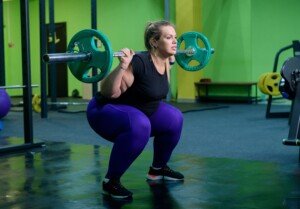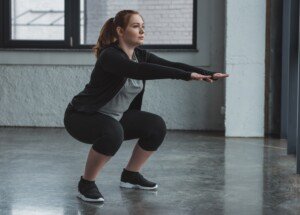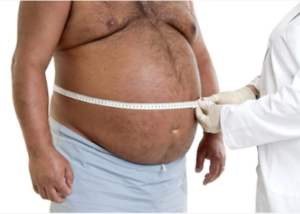
Obesity is no excuse for avoiding the barbell squat, yet very few people at the “squatting cage” qualify as obese.
Every so often there’s an overweight man or woman there, but not what a doctor would consider as obese.
Obesity is not a subjective term. It’s defined as being 20 percent over your ideal weight range. Of course, those weight charts show a pretty roomy range.
Call it obesity, fat, very plus size or very heavy, people who fall into this category would benefit tremendously from barbell squats.
How Big Is Too Obese for Barbell Squats?
Certainly, there’s a point where, for any particular overweight man or woman, they’re just going to be too large to effectively perform a barbell squat.
However, there’s definitely a range of functional obesity (very heavy but still able to assume classic workout body positions and move efficiently through strength training exercises) that is not an impediment to the barbell squat.
Why should the obese perform barbell squats?
• Once a person gets going with this multi-joint movement, as far as getting down the form and progressing with the weight load…it will produce a sense of accomplishment never before experienced.
• Though the barbell squat targets the lower body and also engages the core, it will trigger fat loss in the entire body.
• That’s because the largest muscle groups in the body are recruited, and if the sets are intense, this will cause an elevation in resting metabolism that will persist AFTER the workout is finished.
• As an obese person progresses with this compound exercise, there will be improvements in musculoskeletal function, such as better hip flexibility, fewer aches in the lower back, stronger knees.
Why don’t more obese people perform the barbell squat, then?
The same reason most anybody doesn’t do this exercise. I speculate it’s because it looks intimidating or too difficult.
Perhaps a very heavy person believes that this exercise will make their legs bigger. WRONG! It will shrink fat cells, making you drop pant sizes.
You need to try the barbell squat before making assuming it’s too difficult. In fact…depending on your body’s levers (anthropometrics), you may find that squatting with a barbell across your back is a very compatible exercise.
There’s different ways to position your legs and feet to accommodate different lever proportions.
Getting Started with Barbell Squats if You’re Obese
First start out with bodyweight-only squats. You may be a natural at this, or you may need to work a bit to figure out how to get your thighs parallel to the floor without falling backwards.

Shutterstock/LightField Studios
But do not begin using a barbell until you can cleanly get through eight bodyweight squats with GOOD form and without holding onto anything for balance. Do not get ahead of yourself.
There is nothing intrinsic about obesity that precludes you from performing a barbell squat other than if you’re so large that you can’t even squat.
In the event that you’re too big to effectively squat even with bodyweight only, then you should not attempt squatting for exercise, as it can be very unsafe for your joints.
You would need to lose weight first — enough to safely perform bodyweight squats.
Keep in mind that I have already pointed out that there is a functional range of obesity where the person is still capable of the body positions of strength training.
- Obesity often causes knee pain. If your knees hurt, don’t squat.
- I recommend seeing a sports medicine doctor for an evaluation.
But for many younger obese individuals, knee problems don’t exist, and I’ve seen very heavy people on the leg press and leg extension machines, as well as doing walking lunges.
Keep doing these other exercises, but ADD to them the barbell squat.
Do not let obesity be an excuse for avoiding this exercise just because the majority of people who do it are buff or have swimsuit bodies.
 Lorra Garrick is a former personal trainer certified through the American Council on Exercise. At Bally Total Fitness she trained women and men of all ages for fat loss, muscle building, fitness and improved health.
Lorra Garrick is a former personal trainer certified through the American Council on Exercise. At Bally Total Fitness she trained women and men of all ages for fat loss, muscle building, fitness and improved health.
.


























